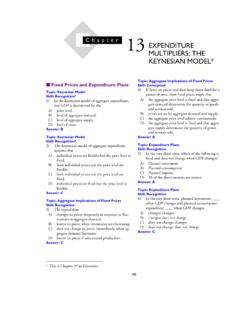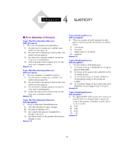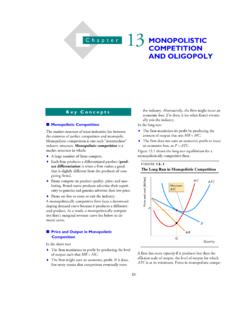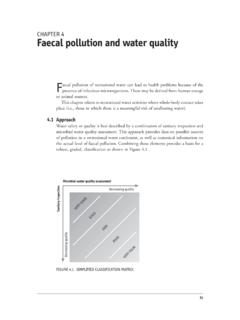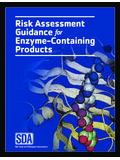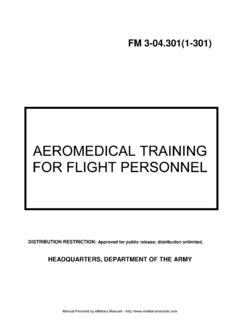Transcription of Chapter 4 The Dose-Response Relationship
1 Chapter 4 The Dose-Response Relationship Introduction The need to establish some criteria to base the relative safety of chemicals is essential. Several methods are used to obtain data in order to establish safe levels and provide information about the relative toxicity of chemicals. Acute Toxicological Studies (1) Information concerning the toxicity of a substance is obtained primarily from either acute or chronic toxicity studies. Acute toxicity studies are the most commonly performed studies for obtaining information on the effects of chemical exposure. They are short-term, relatively inexpensive tests with death of the test animal being the useful observed effect. Information obtained from acute toxicity tests can be used to determine the relative toxicity of different chemicals comparing the respective LD50 values, which are the doses that prove to be lethal for 50 percent of the test animals; identify the target organs (heart, liver, kidneys, etc.)
2 That are affected as a result of exposure; and determine the appropriate doses for long term, chronic studies. Acute Toxicological Studies (2) To perform acute toxicity studies the test animal population is divided into several groups, with an equal number of individuals (usually 10 to 50) in each group. One group of test animals referred to as the control group is exposed to all the same experimental conditions except exposure to the toxic substance. The groups are observed for 14 days, and the number of deaths in each group is recorded. Acute Toxicological Studies (3) LC50 is a measure of chemical toxicity resulting from inhalation. LC means lethal concentration and the subscript has the same meaning as described previous for LD. The unit of measure for the LC50 is usually expressed as part per million (ppm). Chronic Toxicological Studies (1) Chronic toxicity tests may be performed over a period of months, years, or the lifetime of the test animal.
3 Doses of the toxic substance are selected to assure that most of the animals will survive the entire time the study is performed. Different species of test animals may be more or less sensitive to the same toxic chemical. Males and females of the same species may respond differently to the same substance. Although acute and chronic studies provide useful information in evaluating chemical toxicity, it is important to understand that they are not truly representative of the environment to which people are exposed in everyday life. Chronic Toxicological Studies (2) Characteristics of animal studies A single dose A single route of exposure The number of animals exposed is small. The genetic make-up of the population is not very diverse. Only individuals in good health and/or of the same sex are selected. In reality Several different routes Exposure to more than one chemical at a time Greater genetic variability in a larger population the range of responses to a given chemicals more diverse.
4 The collective interactive effect of all these factors on toxicity makes it difficult to establish a cause-effect Relationship . Dose-Response Curves (1) The major purpose for performing acute and chronic toxicity studies is to establish a cause-effect Relationship between exposure to a toxic substance and an observed effect in order to determine a safe exposure level. A curve can be drawn that illustrates the Relationship between the dose administered and the observed response . This curve is referred to as the Dose-Response curve. A Dose-Response curve can be developed form most chemicals. From these curves the threshold level and the relative toxicity of chemicals can be obtained to help establish safe levels of chemical exposure. Dose-Response Curves (2) The threshold is the dose below which no effect is detected or above which an effect is first observed. The threshold information is useful information in extrapolating animal data to humans and calculating what may be considered a safe human dose for a given toxic substance.
5 The threshold dose ( ) is measured as mg/kg/day. It is assumed that humans are as sensitive as the test animal used. To determine the equivalent dose in man the is multiplied by the average weight of a man, which is considered to be 70 kg. Dose-Response Curves (3) The calculation used to determine the safe human dose (SHD) is as follows: substance toxicofmg/day Amount SF(kg) Where SHD = Safe Human dose = Threshold dose at which no effect is observed. 70 Kg = Average weight of a man SF = Safety factor (ranges from 10 to 1000, which varies according to the type of test and data used to obtain the Terminology Associated with Dose-Response Curves (1) No observed effect level (NOEL) The highest tested dose of a substance that has been reported to have no harmful (adverse) health effects on people or animals. No observed adverse effect level (NOAEL) It denotes the level of exposure of an organism, found by experiment or observation, at which there is no biologically or statistically significant ( alteration of morphology, functional capacity, growth, development or life span) increase in the frequency or severity of any adverse effects in the exposed population when compared to its appropriate control.)
6 Terminology Associated with Dose-Response Curves (2) lowest-observed-effect-level (LOEL) Lowest concentration or amount of a substance, found by experiment or observation, that causes any alteration in morphology, functional capacity, growth, development, or life span of target organisms distinguishable from normal (control) organisms of the same species and strain under the same defined conditions of exposure lowest-observed-adverse-effect-level (LOAEL) Lowest concentration or amount of a substance, found by experiment or observation, which causes an adverse alteration of morphology, functional capacity, growth, development, or life span of a target organism distinguishable from normal (control) organisms of the same species and strain under defined conditions of exposure. Terminology Associated with Dose-Response Curves (3) Frank-effect level (FEL) Level of exposure that produces unmistakable and irreversible effects (such as impairment or mortality) at statistically significant increased severity or frequency.
7 The level where overt effects are observed is referred to as the Frank-effect level. Threshold dose dose below which no adverse effects are observable in a population of exposed individuals. Threshold dose approximated by a NOAEL (No Observed Adverse Effect Level) Non-threshold Effects Thresholds are assumed not to exist for genotoxic carcinogens Safe dose for Threshold Effect NOAEL approach Identify the adverse effect that occurs at the lowest dose Determine the NOAEL or LOAEL for that endpoint Divide NOAEL/LOAEL by uncertainty factors Acceptable Daily Intake ADI estimated (maximum) amount of an agent, expressed on a body mass basis, to which a subject may be exposed over his lifetime without appreciable health risk (also TDI, tolerable daily intake) ADI derived from NOAEL by the use of uncertainty factors UFs (or safety factors SFs) Reference dose (RfD) RfD is an estimate of the daily exposure that is likely to be without appreciable health effect even if continued exposure occurs over a lifetime.
8 Uncertainty Factors Default values: UFinterspecies = 10 , UFhuman variability = 10 Additional Uncertainty Factors Sometimes applied: UFLOAEL-NOAEL = 3 or 10 UFsubchronic-chronic = 3 or 10 UF database insufficiences = up to 10 MF, modifying factor for professional judgement: up to 10 RfD = NOAEL (or LOAEL) / UF1 UF2 UF3 MF Benchmark dose Approach (1) NOAEL approach uses only single points, shape of Dose-Response is ignored. Bench mark dose (BMD) is calculated from the curve fitted to the dose -reponse data, so all information is used. BMD can only be used when available data are suitable for modelling. Not replacement for NOAEL, but additional tool Benchmark dose Approach (2) mathematical model is applied to the experimental data to produce a Dose-Response curve of best fit. statistical calculation an upper 95% confidence limit of the curve is determined Benchmark response is defined as 10% (or 5%, or 1%).
9 Benchmark dose corresponds to the bench mark response on the upper confidence limit curve. Benchmark dose Approach (3) Non-threshold? Absence of a detectable effect at low doses is either because the dose is below a threshold or because the response is below the level that can be detected by the test sytem. Threshold or Non-threshold Presence of a threshold cannot be proven from experimental data. Conclusions about existence of a threshold are based on biological plausibility and expert judgement. Genotoxic effects (DNA dammage leading to cancer) are thought to be possible at any level of exposure, so no threshold. Low- dose Extrapolation Dose-Response curve is use to extrapolate to doses lower than then the experimental region. Calculated Risk or Safe dose Extrapolation may be used to calculate: the risk associated with a known intake. intake associated with a de minimis risk, an increased life time risk of developing cancer of 1 in 106 ( virtually safe dose , VSD).
10 Linear Low- dose Extrapolation Assumption: linear Relationship between dose and biological response Linear Extrapolation from LED10 LED10 low confidence limit of dose with response of 10% From LED10 to VSD If LED10 = 57 mg/kg/day ( response 10% or 0,1) then VSD (virtual safe dose , response 1 in 106 or 10-6) = 57 x 10-6 / 0,1 = 5,7 x 10-4 mg/kg/day ALARA Approach For genotoxic carcinogens (non-threshold effects) also the ALARA-approach may be followed: exposure to be reduced to as low as reasonably achievable (ALARA) or as low as reasonably practical (ALARP) Relative Toxicity (1) A comparison of the Dose-Response curves for two or more different chemicals administered to the same type of test animal can be used to determine the relative toxicity of the chemicals. The LD50 for chemical A is less than the LD50 for chemical B. Therefore, chemical A is considered more toxic than chemical B. Relative Toxicity (2) Chemical A is more toxic than chemical B at the higher doses, but at the lower doses chemical B is more toxic than chemical A.


